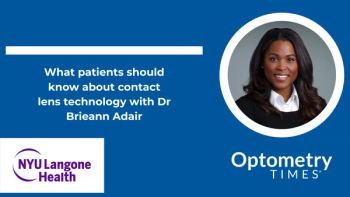
- July digital edition 2021
- Volume 13
- Issue 7
Moving beyond refractive error correction
Prepare for the future of contact lenses with innovations on the horizon
Published in April 2021, the British Contact Lens Association Contact Lens Evidence- based Academic Reports deliver a global consensus on contact lens practice and research. The final report focuses on contact lens technologies of the future,1 and, as highlighted by Optometry Times®’ recent conversation with the report’s chair Professor Lyndon Jones, PhD, FCAHS, FCOptom, FAAO, in many cases those developments will move the function of a contact lens beyond simple correction of refractive error.
Given that knowledge, what novel contact lens technologies can eye care practitioners expect to see become available? When might that happen and importantly, what can eye care practitioners do along to the way to prepare?
The here and now
It can be surprising to realize that the profession is already at the tip of the innovation “iceberg.” The FDA’s approval in November 2019 of the first soft contact lens design for slowing myopia progression in children (MiSight 1 day; CooperVision) opened the door to broader access to technologies that do more than simply correct eyesight. This is an example of a contact lens with an optical design intended to be used to affect the rate of axial length growth in young myopes, and evidence grows for such technologies for both soft2-4 and orthokeratology5,6 designs.
Innovation drives changes in practice Myopia management also serves as a good indication of how contact lens innovation will change some aspects of clinical practice. Anyone involved in offering this treatment to patients will appreciate the different conversation required when counseling patients and their caregivers about the technology.
It also creates a need for eye care practitioners to increase their own knowledge and continue to stay up to date in an ever-evolving field. Myopia management may also result in changes to clinic appointments, an investment in additional instrumentation, and the introduction of professional fees to appropriately cover the service offered. All of these serve as examples of changes that eye care practitioners can expect as new lens technologies become available.
The diagnosis and monitoring of ocular disease continues to be a focus for contact lens development, with one example already commercially available in some markets. The addition of a strain gauge in combination with onboard microelectronics delivers the ability to continuously monitor intraocular pressure measurements over a 24-hour period to provide information to optimize glaucoma treatment (Sensimed Triggerfish).7
The recent regulatory approval in Japan8 and Canada of the first drug-delivering contact lens (Acuvue Theravision, Johnson & Johnson Vision) demonstrates how close this technology may be to becoming commercially available. The novel ketotifen- releasing technology has been shown to significantly reduce symptoms of ocular allergy for up to 12 hours.9
Within the next 10 years
Manufacturers need to move from proof of principle in the early stages of development, through to demonstrating efficacy and safety in clinical trials, gaining regulatory approvals, and finally launching a commercially viable product. That means eye care practitioners can expect access to a suite of novel devices to gradually, rather than suddenly, increase in the future. These technologies, once available, will be valuable additions to patient-centered health care. Tears are a rich source of data for the detection and monitoring of systemic and ocular disease. Such data include blood glucose levels in diabetes, the detection of cancer biomarkers, and the diagnosis and monitoring of dry eye disease via measures of osmolarity and inflammatory cytokines.1
The management of ocular disease will be a further welcome addition to clinical practice, especially for those conditions now predominantly treated with topical medications. The limitations of self-application of drops, poor adherence from patients instilling the drops, short drop residence time on the ocular surface, and the requirement for acute conditions of round-the-clock dosing are well understood, leading to understandable interest in drug-releasing technology.
Beyond ocular allergy, expect to see innovation in the treatment of dry eye disease via sustained release of lubricants and anti-inflammatory and immunomodulatory agents as well as in the treatment of acute ocular infection such as bacterial keratitis via antibiotic drug-delivering contact lenses.
Looking further
The separate technologies outlined above may ultimately end up coming together in a new discipline for contact lenses: theranostics. Be prepared to hear more about this over time, becoming familiar with a medical field that brings diagnostics and therapeutics together. The possibilities are there for a smart contact lens that can detect and monitor the levels of inflammatory biomarkers, such as matrix metallopeptidase 9, or MMP-9, in dry eye disease and then deliver an appropriate amount of drug to the ocular surface to treat this problem when those levels are sufficiently elevated.
Smart contact lenses as a broad category provoke much consumer interest. Incorporating electronics into the contact lens leads to the attractive non-medical application of augmented vision, with futuristic descriptions of viewing social media and email via a contact lens. A much-publicized scleral lens (Mojo Vision) has demonstrated the early potential of this head-up display option, although no lens is commercially available yet.
Many applications of augmented vision exist beyond the use for non-medical purposes, and some of the first available lenses will likely be for low vision enhancement or even automatically focusing lenses for presbyopia. The addition of electronics to a contact lens brings with it many challenges, not least how to make those additions small enough, and how to power them, which means these technologies are still potentially further out in the timeline.
Time to take action
Although some innovations remain a number of years away, as illustrated, others are with us already or imminent. Eye care practitioners who keep pace with the possibilities generated by each new technology will be best placed to embrace the changes as they come, offering their patients the latest in contact lens diagnostics, therapeutics, and optical enhancements.
For now, the advice is to stay alert and up to date. Be prepared to make necessary changes to your practice, clinical services, and fees. Additionally, consider beginning to counsel your patients on what may be coming, making them aware of relevant technology and ensuring they are open to trying them as soon as they land in the real world.
Reference
1. Jones L, Hui A, Phan CM, et al. CLEAR – contact lens technologies of the future. Cont Lens Anterior Eye. 2021;44(2):398- 430. doi:10.1016/j.clae.2021.02.007
2. Cooper J, O’Connor B, Watanabe R, et al. Case series analysis of myopic progression control with a unique extended depth of focus multifocal contact lens. Eye Contact Lens. 2018;44(5):e16-e24. doi:10.1097/ICL.0000000000000440
3. Chamberlain P, Peixoto-de-Matos SC, Logan NS, Ngo C, Jones D, Young G. A 3-year randomized clinical trial of MiSight lenses for myopia control. Optom Vis Sci. 2019;96(8):556-567. doi:10.1097/ OPX.0000000000001410
4. Walline JJ, Walker MK, Mutti DO, et al; BLINK Study Group. Effect of high add power, medium add power, or single-vision contact lenses on myopia progression in children: the BLINK randomized clinical trial. JAMA. 2020;324(6):571-580. doi:10.1001/ jama.2020.10834
5. Si JK, Tang K, Bi HS, Guo DB, Guo JH, Wang XR. Orthokeratology for myopia control: a meta-analysis. Optom Vis Sci. 2015;92(3):252-257. doi:10.1097/OPX.0000000000000505
6. Sun Y, Xu F, Zhang T, et al. Orthokeratology to control myopia progression: a meta-analysis. PLoS One. 2015;10(4):e0124535. doi:10.1371/journal.pone.0124535
7. Chen X, Wu X, Lin X, Wang J, Xu W. Outcome, influence factor and development of CLS measurement in continuous IOP monitoring: a narrative review. Cont Lens Anterior Eye. Published October 19, 2020. doi:10.1016/j.clae.2020.10.006
8. Johnson & Johnson Vision receives approval of world’s first and only drug-releasing combination contact lens for vision correction and allergic eye itch: Acuvue Theravision with Ketotifen. Press release. Johnson & Johnson Vision. March 24, 2021. Accessed June 11, 2021. https://www.prnewswire.com/news-releases/ johnson--johnson-vision-receives-approval-of-worlds-first-and-onlydrug- releasing-combination-contact-lens-for-vision-correction-andallergic- eye-itch-acuvue-theravision-with-ketotifen-301254442. html
9. Pall B, Gomes P, Yi F, Torkildsen G. Management of ocular allergy itch with an antihistamine-releasing contact lens. Cornea. 2019;38(6):713-717. doi:10.1097/ICO.0000000000001911
Articles in this issue
over 4 years ago
Quiz: OCT helps diagnose macular pathologyover 4 years ago
Gain new technology insight by partneringover 4 years ago
Komono brings new suns to its Illusions lineover 4 years ago
How plant oils may help dry eyeover 4 years ago
Ongoing COVID-19 protocolover 4 years ago
Low vision rehab in diabetic vision lossover 4 years ago
OCT helps diagnose macular pathologyNewsletter
Want more insights like this? Subscribe to Optometry Times and get clinical pearls and practice tips delivered straight to your inbox.





